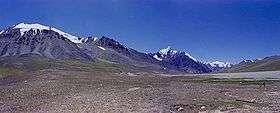Khunjerab National Park
| Khunzerav National Park | |
| Land: | 560,714 acres |
| Region: | Gilgit-Baltistan |
| Founded: | 1975 |

Khunzerav National Park or (commonly mispronounced as Khunjerab) is a national park in Gilgit Baltistan, Pakistan.[1] Khun means "blood" and Zerav means "to stream" in Wakhi, the native language of the region. The name has been wrongly pronounced and written for a long time because Wakhi had not developed as much and commonly mispronounced by speakers of other languages.
Initiation
Khunzerav National Park was established primarily as a means to protect the Marco Polo sheep (as well as snow leopards and bharal) living in the area.[2] The borders of the park were mapped by Schaller in 1974, after a short field survey. The park was formally established on April 29, 1979 by Prime Minister of Pakistan Zulfikar Ali Bhutto, who said that "it must become a world famous park".[3]

Despite being listed as a category 2 national park, banning human activities including agriculture and hunting, the park was poorly managed, meaning that illegal hunting of the Marco Polo sheep continued. Because of this, the International Union for Conservation of Nature commissioned Norwegian biologist Per Wegge to do a wildlife survey of the park in 1988.[4] Wegge found that there was no evidence of competition between the domestic sheep being illegally grazed and the wild Marco Polo sheep, and that most of the illegal hunting was not being done by local Wakhi residents.[4] He therefore proposed that the park be reclassified, allowing grazing and commercial hunting, with the profits going to local residents. However, the government overlooked Wegge's suggestions, instead drawing up a new management plan, which both the IUCN and the World Wildlife Fund supported as a means to preserve the park and protect the wildlife. Wegge was critical of the government scheme, claiming that it was based on financial considerations, with the Pakistani government hoping to attract tourists to the area. The IUCN agreed with this, and has since distanced itself from the national park.[5] To help protect the animals from poaching, the WWF has created the Khunzerav Village Organization, which relies on people living in the area to report poaching or endangered animal sightings.[6] Khunzerav National Park is Pakistan's third largest national park. It is adjacent to Taxkorgan Natural Reserve (1,400,000ha) in China. This park was created on 29 April 1975 on the recommendation of wildlife biologist Dr. George Schaller. Over half of the park is above 4,000m. Khunjerab Pass, the gateway to China via the Karakoram Highway, is at 4,934m.
Wildlife
The primary purpose of this park was to provide protection to the endangered Marco Polo sheep, which is only found in this area in Pakistan. According to the Mir of Hunza, the population of sheep was around 400 but had dropped to below 180 by the time of the completion of the Karakoram Highway. A herd of almost 75 Marco Polo sheep was recorded in the spring of 1984 and park staff saw at least 50 crossing the pass in May 1989.
The park is also famous for its snow leopards. Some reports say that it might contain the highest density of these beautiful cats in the total Himalayan ecosystem, which is the natural habitat of these cats. Over 2,000 Siberian ibex, widely distributed and abundant in the park but absent from neighbouring China, are also present here.
Mammals
Total species: 16. Mammals in the park include:
- Snow leopard (T)
- Himalayan ibex (C)
- Brown bear (T)
- Tibetan red fox (C)
- Tibetan wolf (T)
- Blue sheep (in Shimshal area only) (V)
- Marco Polo sheep (T)
- Tibetan wild ass or kiang (unconfirmed reports) (?)
- Ermine (C)
- Alpine weasel (?)
- Stone martin (C)
- Golden marmot (C)
- Lynx (unconfirmed reports) (?)
- Large-eared pika (C)
- Dhole (unconfirmed reports) (?)
- Cape hare (C)
- Common field mouse (C)
- Royle's mountain vole (C)
- Lesser shrew (C)
- Migratory hamster (C)
Note: T=Threatened, V=Vulnerable, R=Rare, C=Common, ?=Unknown.
Birds
Total species: 66. Common birds in the park are:
- Lammegier vulture
- Golden eagle
- Himalayan griffon vulture
- Eurasian black vulture
- Marsh harrier
- Eurasian sparrow hawk
- Eurasian kestrel
- Lesser kestrel
- Saker falcon
- Peregrine falcon
- Himalayan snow cock
- Snow partridge
- Chukar
- Grey heron
- Common sandpiper
- Hill pigeon
- Snow pigeon
- Northern eagle owl
- Eurasian cuckoo
- Common swallow
- Magpie
- Alpine chough
- Raven
See also
References
- ↑ "Khunjerab National Park". World Wildlife Fund. Retrieved May 5, 2012.
- ↑ Kemf 1993, p. 141
- ↑ Kalland & Bruun 1995, p. 108
- 1 2 Kalland & Bruun 1995, p. 109
- ↑ Kalland & Bruun 1995, p. 110
- ↑ Khan 2008
External links
| Wikimedia Commons has media related to Uncia uncia. |
- WWFPak.org - Khunjerab
- Objects of Desire in the Northern Areas - Report by John Mock, UC Berkeley
- Mountain Protected Areas in Pakistan - Report by John Mock, UC Berkeley
Coordinates: 36°35′13″N 75°23′59″E / 36.58700332°N 75.39986078°E